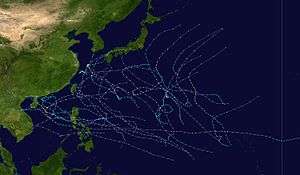Typhoon Alice (1979)
| Typhoon (JMA scale) | |
|---|---|
| Category 3 typhoon (SSHWS) | |
 Typhoon Alice near peak intensity on January 7, 1979. | |
| Formed | December 31, 1978 |
| Dissipated | January 14, 1979 |
| Highest winds |
10-minute sustained: 175 km/h (110 mph) 1-minute sustained: 205 km/h (125 mph) |
| Lowest pressure | 930 hPa (mbar); 27.46 inHg |
| Fatalities | 0 |
| Damage | Extensive |
| Areas affected | Marshall Islands |
| Part of the 1978 and 1979 Pacific typhoon seasons | |
Typhoon Alice was an unusual late-season Pacific typhoon that formed in late 1978 and persisted into January 1979. Typhoon Alice also caused extensive damage in the Marshall Islands, but no fatalities occurred. The storm formed on the final day of 1978 and became a tropical storm on January 1. On January 5, Alice gained typhoon status, and its first peak intensity was reached on January 8. After weakening, the storm attained a secondary peak intensity on January 11. Typhoon Alice lasted for about 15 days in the Northwestern Pacific before dissipating on January 14, 1979.
Meteorological history

The origins of Typhoon Alice were traced back to a tropical low on December 27, 1978, meandering in the open Pacific. The wave developed into a tropical depression at a low latitude in the Northwestern Pacific basin on December 31, 1978. In the early morning hours of January 1, a tropical cyclone formation alert was issued. Soon after, Tropical Storm Alice formed at 2.5° N[1], making it one of the southernmost forming storms on record in the Northwestern Pacific basin. Between the next couple of days, Alice meandered through the Marshall Islands, causing very extensive and heavy damage. An upper air, short-wave trough steered it on a northeasterly track, according to several satellite reconnaissance fixes. On January 5, Tropical Storm Alice gained typhoon status as the storm began to take a westerly path. As the shortwave trough continued eastward, the subtropical ridge quickly established itself north of Alice producing strong easterly steering flow, temporarily accelerating the system toward the northwest. Over the next few days, gradual strengthening occurred as Alice moved west. Late on January 7, Typhoon Alice attained a peak intensity of 125 miles per hour (201 km/h) and a pressure of 930 millibars (27 inHg), before accelerating to a forward speed of nearly 14 knots (16 mph) as Alice began to weaken. On January 9, Alice began further weakening as the storm began an unexpected northward turn as a shear-line merged into Typhoon Alice while it was southeast of Guam. However, restrengthening occurred on January 11 and a secondary peak intensity of 115 miles per hour (185 km/h) and a pressure of 940 millibars (28 inHg). Soon after, further weakening occurred and soon started to encounter shear. By January 13, the storm had weakened significantly after its secondary peak intensity. Typhoon Alice dissipated on January 14, 1979, due to very strong vertical shear.[2][3][4]
Impact
During Alice's passage, the storm was only a tropical storm. However, due to slow movement over the island nation, damage was extensive. One week after Typhoon Alice's passage, President Jimmy Carter declared the Marshall Islands as a disaster area. No fatalities were reported, and no other land areas were reported to be affected by Typhoon Alice during its lifetime.[2][4]
See also
- Other systems named Alice
- List of near-Equatorial tropical cyclones
- Typhoon Hester (1952) - A similar strong typhoon that formed in December and persisted into January.
- Typhoon Mary (1977) - An erratic typhoon that struck the Philippines in January 1978, although it formed in 1977.
References
- ↑ "Alice 1978 Best Track data". USNO.navy. Joint Typhoon Warning Center. Retrieved 2 October 2017.
- 1 2 https://books.google.com/books?id=c1Li_2CfMgQC&pg=RA12-PA91&lpg=RA12-PA91&dq=typhoon+alice+1979&source=bl&ots=Agbcf5YaZ_&sig=3PuMjMPvLTTGCr0f5_GdB_zdCL0&hl=en&sa=X&ved=0ahUKEwjAzLewtNDWAhXD4CYKHRHEAdMQ6AEIajAO#v=onepage&q=typhoon%20alice%201979&f=false
- ↑ http://www.jma.go.jp/jma/jma-eng/jma-center/rsmc-hp-pub-eg/Besttracks/bst7079.txt
- 1 2 1979 ATCR
